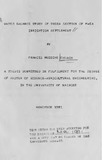| dc.description.abstract | At present the Thiba and Nyamindi rivers are
unable to meet the demands for the rice production.
Therefore Water Balance Study was conducted in Thiba
Section of Mwea Irrigation Scheme to seek more information
regarding water utilizatio.n in the Scheme.
The main objectives were: to determine the
water require~ents at various stages of rice cultivation
under present management; to determine seepage
and percolation losses in unit ,feeders; to in-
/
vestigate the'canal damage by water erosion, human
beings and animals and to recommend ways and means
of improving the current water management.
Each Unit had a constant-head orifice eCHO)
at the outlet. Weirs were installed at the outlets
of the Units. The inflow and outflow data were
collected at least twice daily. Piezometers were
installed in selected nuraeries of the above Units
at three levels. The weather data were collected
twice a day. All readings were expressed in mm/day.
From this study it was f~und that rice growth
and development stages consumed the most effective
water - 44.8% of total effective water supplied to
)
Thiba Section, followed by water topping stage
38.8%, and land preparation stage needed 16.4% of
the total effective water. Of the total water
supplied for the rice production in Thiba Section,
river water constituted about 85.9% while rainfall
water constituted 14.1%. The total irrigation water
was utilised as follows:- 135.0% lost through evapotranspiration;
34.~% passed out of the fields as outflow;
7.9% was lost as deep percolation and 23.0%
was stored in the soil.
The tota~ estimated effective water requirements
for 1979/80 season were 2667 ha-metres. The
effective water requirements per hectare for the
1979/80 season was 2.34 ha-metres; effective water
required per 0.405 ha holding (one-acre holding) for
3
the same season was 0.95 ha-metres (9500 m );
effective water required to produce 1 kg of paddy
3
rice was 4.19 m and effective water required to
3
produce a 75 kg bag of paddy rice was 313.95 m •
Owing to canal damage the main canal capacity is
83.4% greater than original capacity; the main
canal gradient has increased from 1:3500 to 1:540.
The side slopes are non-uniform. The shape of the
canal cross-section has changed from trapezoidal to
(iii)
parabolic. Similar changes have taken place in
the branch canals. The canal seepage losses are
negligible once the soil is saturated. However,
when the canals are dry and badly cracked, the
seepage losses are 7.5 mm/hour for the first
twelve hours. After twelve hours the seepage
losses are almost zero.
From this study it was concluded that the
irrigation water should be managed better than it
was then; the water usage can be minimised if water
topping stage can be reduced, the soils in the Units
H1, H2, H3 and H20 did not have any drainage problems.
Water table rises during the growing season
and then falls below 150 cm during and after the
harvesting stage. The water qUality for both
Irrigation and drain waters was good. Although
horizontal flow was prevented in the experimental
plots, such flow occurred from the field to the
drain in practice.
To improve the present water management the
following recommendations were made:-
1. The technical staff in-charge of water control
needs training in water management.
( Lv )
Irrigation officers should have a sufficient
knowledge of irrigation practices.
2. The tenants need to be educated in proper
water utilization and management. They should
be closely supervised to avoid misuse of water.
3. The existing water measuring structures need
regular maintenance.
4. Additional water measuring structures should
be installed in various canals and drains.
5. Water measuring scheme shoUld be worked out
as a part of water management in the settlement.
6. As the maximum water requirements are at
transplanting and tillering stages, the
possibility of building a storage dam should
be investigated.
7. At the moment the rice growth depends on the
availability of irrigation. The utilization
of long rains needs more studies with an aim
of having two crops per year. | en |

